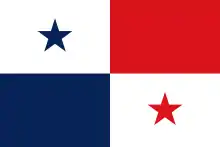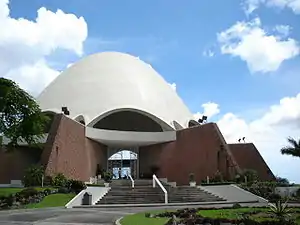Religion in Panama
Christianity is the main religion in Panama. An official survey carried out by the government estimated in 2020 that 80.6% of the population, or 3,549,150 people, identifies itself as Roman Catholic, and 10.4 percent as evangelical Protestant, or 1,009,740.[1] The Jehovah's Witnesses were the third largest congregation comprising the 1.4% of the population, followed by the Adventist Church and The Church of Jesus Christ of Latter-day Saints with the 0.6%. There is a very large Buddhist (0.4% or 18,560) and Jewish community (0.1% or 5,240) in the country. The Baháʼí Faith community of Panama is estimated at 2.00% of the national population, or about 60,000[3] including about 10% of the Guaymí population;[4] the Baháʼís maintain one of the world's eight Baháʼí Houses of Worship in Panama.[5]
| Part of a series on the |
| Culture of Panama |
|---|
 |
| History |
| People |
| Languages |
| Cuisine |
| Religion |
| Art |
| Literature |
| Sport |
|

The Church of Jesus Christ of Latter-day Saints (Mormons) claim more than 40,000 members.[6] Smaller religious groups include Buddhists with between 15,000 and 20,000 members, Seventh-day Adventists, Jehovah's Witnesses, Episcopalians with between 7,000 and 10,000 members, Jewish and Muslim communities with approximately 10,000 members each, Hindus, and other Christians.[5] Indigenous religions include Ibeorgun (among Kuna) and Mamatata (among Ngobe).[5] There is also a small number of Rastafarians.[5]

Catholics are found throughout the country and at all levels of society.[5] Evangelical Christians also are dispersed geographically and are becoming more prominent in society.[5] The mainstream Protestant denominations, which include Southern Baptist Convention and other Baptist congregations, United Methodist, Methodist Church of the Caribbean and the Americas, and Lutheran, derive their membership from the Antillean black and the expatriate communities, both of which are concentrated in Panamá and Colón Provinces.[5] The Jewish community is centered largely in Panama City.[5] Muslims live primarily in Panama City and Colon, with smaller concentrations in David and other provincial cities.[5] The vast majority of Muslims are of Lebanese, Palestinian, or Indian descent.[5]
The Constitution provides for freedom of religion, with some qualifications, and the Government generally respected this right in practice.[5] It also declares Roman Catholicism to be the religion of majority, and says it should be taught in schools. [7] The US government reported that there were no reports of societal abuses or discrimination based on religious belief or practice in 2007.[5]
See also
- Christianity in Panama
- Roman Catholicism in Panama
- Baháʼí Faith in Panama
- Islam in Panama
- Hinduism in Panama
- Freedom of religion in Panama
References
- "Segunda Encuesta Nacional de Hogares, Panama 2020" (PDF). Ministerio Público de la República de Panamá. December 2020.
- Katzman, Patricia. Panama. Hunter Publishing (2005), p106. ISBN 1-58843-529-6.
- "Panama". WCC > Member churches > Regions > Latin America > Panama. World Council of Churches. 2006-01-01. Archived from the original on 2008-07-08. Retrieved 2008-07-01.
- International Community, Baháʼí (October–December 1994). "In Panama, some Guaymis blaze a new path". One Country. 1994 (October–December).
- International Religious Freedom Report 2007: Panama. United States Bureau of Democracy, Human Rights and Labor (September 14, 2007). This article incorporates text from this source, which is in the public domain.
- Panama Archived 2008-02-21 at the Wayback Machine. LDS Newsroom. Retrieved 2008-12-13
- "Panama Constitution on Religion - Google Search". www.google.com. Retrieved 2021-01-26.
External links
- Religious radiostations in Panama List with over 20 online broadcasting Panamanian radiostations
- Segunda Encuesta Nacional de Hogares, Panama 2015 via WaybackMachine
.svg.png.webp)